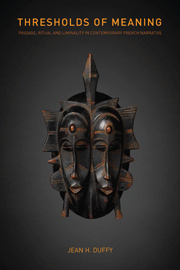Book contents
- Frontmatter
- Contents
- Acknowledgements
- List of illustrations
- Introduction
- 1 At death's door: illness, ritual and liminality in Darrieussecq, Lenoir, and Mauvignier
- 2 Suicide and saving face in Bon, Mauvignier and Bergounioux
- 3 Commemoration, monument and identity in Bergounioux, Darrieussecq and Rouaud
- 4 Retouching the past: family photographs and documents in Rouaud, Bon and Lenoir
- Conclusion: Writing passage and the passage to writing
- Notes
- Select bibliography
- Index
4 - Retouching the past: family photographs and documents in Rouaud, Bon and Lenoir
- Frontmatter
- Contents
- Acknowledgements
- List of illustrations
- Introduction
- 1 At death's door: illness, ritual and liminality in Darrieussecq, Lenoir, and Mauvignier
- 2 Suicide and saving face in Bon, Mauvignier and Bergounioux
- 3 Commemoration, monument and identity in Bergounioux, Darrieussecq and Rouaud
- 4 Retouching the past: family photographs and documents in Rouaud, Bon and Lenoir
- Conclusion: Writing passage and the passage to writing
- Notes
- Select bibliography
- Index
Summary
In the first hundred and twenty years following photography's invention, analysis of the new medium was dominated by discussion of three central issues: its relationship with art and its impact on and implications for painting; the photograph's status as objective trace and its potential as a means of recording and, indeed, knowing the world; the technological advances that constantly refined the camera's capacity to replicate reality and democratised access to photographic practice. With the exception of a few sceptical voices, for most commentators, the documentary, indexical status of photography was a given. If Dadaist and Surrealist experimentation – the photomontages, the solarised images, rayographs and double exposures resulting from the exploitation of the photographic ‘accident’ – challenged the ‘transcriptive realism expected of photography’ (Wells, 2004b [1996], 272), the analogical conception of the medium proved to be extremely resilient, bolstered as it was by the development of philanthropic journalism and the photo-essay, by the establishment of photographic archives within museums and libraries and by successive advertising campaigns that consistently stressed the opportunities the camera offered the amateur to preserve a record of his/her own experience (West, 2000). However, as the twentieth century progressed and as concepts such as representation, referentiality and truth were systematically unpicked, the reliability of the photographic image was more frequently challenged and analysts turned their attention to the tension between the physical and chemical processes that confer on photography its indexicality and the various features and practices militating against the faithful replication of reality.
- Type
- Chapter
- Information
- Thresholds of MeaningPassage, Ritual and Liminality in Contemporary French Narrative, pp. 191 - 258Publisher: Liverpool University PressPrint publication year: 2011

